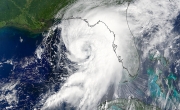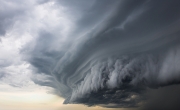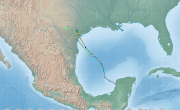Summer 2018 | The Hurricane Weather Research and Forecast system (HWRF) is one of NOAA’s operational models used to predict the track, intensity, and structure of tropical cyclones. Each winter, scientists at NOAA’s Environmental Modeling Center (EMC), the Developmental Testbed Center (DTC), and NOAA’s Hurricane Research Division (HRD) perform testing and evaluation (T&E) on possible changes to the HWRF physics schemes, dynamic core, and data assimilation system that have the potential to improve HWRF predictions. Many of these… Read More
Bridges to Operations: Tests Conducted at DTC Lead to Operational Implementation of Innovations in Physics and Data Assimilation in HWRF

Visitors: Impact of Vertical Advection Schemes of the Hydrometeors on the Simulated Hurricane Structure and Intensity
Visitor: Shaowu Bao

Summer 2018 | Advection is a computationally expensive process in Numerical Weather Prediction (NWP) models. Therefore, time-sensitive operational forecast models sometimes sum up the hydrometeors, including cloud water, rainwater, ice and snow, prior to calling the advection scheme. For this configuration, the model only needs to calculate the advection of the total condensate. However, the impact of such a time-saving technique has not been systematically evaluated. With the release of HWRF 3.9a, a version of the operational HWRF… Read More
Community Connections: 2018 DTC Community Unified Forecast System Test Plans and Metrics Workshop
July 30 - August 1, 2018
Summer 2018 | The 2018 DTC Community Unified Forecast System Test Plan and Metrics Workshop was held at NOAA’s National Center for Weather and Climate Prediction (NCEP) on July 30 - August 1, 2018. The major goal of this workshop was to work towards a community test plan with common validation and verification metrics for the emerging Unified Forecast System (UFS). The plan will serve as a guide for the Numerical Weather Prediction (NWP) community for testing and evaluating new developments for the UFS models and components by… Read More
Announcement: 2018 DTC Community Unified Forecast System Test Plan and Metrics Workshop
July 30 - August 1, 2018, National Center for Weather and Climate Prediction (NCWCP), College Park, MD

2018-05-01 | The Developmental Testbed Center (DTC) is pleased to announce an upcoming community workshop on Numerical Weather Prediction test plan and metrics for model validation and verification. Now available: Agenda | Registration | Logistics The workshop, to take place at the NCWCP in College Park, MD, will be held for two and a half days prior to the NGGPS Strategic Implementation Planning (SIP) meeting at the same location. The major goal of this workshop is to develop a community test plan with common validation and… Read More
Software Release: Release of the Community Standalone GFDL Vortex Tracker Code Version 3.9a

2018-04-13 | The DTC’s HWRF team is pleased to announce the public release of the Community standalone GFDL Vortex Tracker code version 3.9a. The standalone tracker can be used to determine properties (location, intensity, structure etc) of forecast tropical… Read More
Software Release: Release of the Common Community Physics Package (CCPP)
A Library of Physical Parameterizations for Atmospheric Numerical Models

2018-04-09 | The DTC’s Global Model Test Bed (GMTB) is pleased to announce the public release of the Common Community Physics Package (CCPP), a library of physical parameterizations for atmospheric numerical models. It is distributed with a framework that enables its use with any host application for which an interface is written. In this release, the CCPP has been bundled with the GMTB Single Column Model (SCM) and contains all the physical parameterizations used in the current operational NOAA Global Forecast System (GFS). For more… Read More
Lead Story: Keeping up with Model Testing & Evaluation Advances: New Verification Displays
Winter 2014 | As numerical model predictions and functions proliferate and move toward ever higher resolution, verification techniques and procedures must also advance and adapt.
Lead Story: THE 2013 HURRICANE WRF
Summer 2013 | As the 2013 hurricane season continues in the North Atlantic and eastern North Pacific basins, a newly minted HWRF model is providing forecasts for the National Hurricane Center (NHC) on a new machine and with significant code additions. On July 24, the operational HWRF went live on the Weather and Climate Operational Supercomputing System (WCOSS). A research version for testing continues in use on the jet computers at the NOAA ESRL Global Systems Division. New, more efficient code promises to provide… Read More
Lead Story: Mesoscale Model Evaluation Testbed
ASSISTING WITH THE TRANSITION OF PROMISING NWP TECHNIQUES FROM RESEARCH TO OPERATIONS
Spring 2013 | The DTC provides a common framework for researchers to demonstrate the merits of new developments through the Mesoscale Model Evaluation Testbed (MMET). Established in the Fall of 2012, MMET provides initialization and observation data sets for several case studies and week-long extended periods that can be used by the entire numerical weather prediction (NWP) community for testing and evaluation. The MMET data sets also include baseline results generated by the… Read More
Director's Corner: Bill Lapenta
Summer 2013 | Dear Colleagues, The end-to-end modeling systems in the NOAA operational numerical guidance suite are scientifically based, and research results must and do cross the “Valley of Death” into operations. However, the operational and research communities need to make this journey more efficient and cost effective. That’s one reason why we have testbeds like the DTC. During 20 years as a research scientist at NASA, I had the opportunity to work closely… Read More
Director's Corner: Welcome Message by Bill Kuo
Dear Colleagues,
Spring 2013 | Welcome to the first issue of a quarterly newsletter for the Developmental Testbed Center (DTC). The research to operations (R2O) transition in numerical weather prediction (NWP) is a major challenge facing the U.S. meteorological community. It has been recognized that the U.S. has the largest community around the world working on weather research and numerical modeling. Yet, most of these research results do not directly benefit operational NWP. The DTC was established in 2003 with a mission to… Read More
Pagination
Copyright © 2025. All rights reserved.